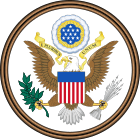Former Soviet Union Demilitarization Act of 1992 facts for kids
 |
|
| Other short titles |
|
|---|---|
| Long title | An Act to authorize appropriations for fiscal year 1993 for military activities of the Department of Defense, for military construction, and for defense activities of the Department of Energy, to prescribe personnel strengths for fiscal year for the Armed Forces, to provide for defense conversion, and for other purposes. |
| Acronyms (colloquial) | FSUMA |
| Nicknames | National Defense Authorization Act for Fiscal Year 1993 |
| Enacted by | the 102nd United States Congress |
| Effective | October 23, 1992 |
| Citations | |
| Public law | 102-484 |
| Statutes at Large | 106 Stat. 2315 aka 106 Stat. 2563 |
| Codification | |
| Titles amended | 22 U.S.C.: Foreign Relations and Intercourse |
| U.S.C. sections created |
|
| Legislative history | |
|
|
The Former Soviet Union Demilitarization Act of 1992 was a United States federal law. It was created to help with efforts to reduce weapons in the countries that used to be part of the Soviet Union. This law is also known as the National Defense Authorization Act for Fiscal Year 1993.
It gave the United States Department of Defense the power to support programs. These programs focused on changing weapons, getting rid of chemical weapons, and stopping the spread of dangerous weapons. The Act was signed into law by President George H. W. Bush on October 23, 1992.
Contents
Why Was This Act Needed?
In the early 1990s, big changes happened around the world. The Berlin Wall fell, and the Soviet Union broke apart. Many countries became independent. This meant there were a lot of weapons, including nuclear ones, in new hands.
The U.S. Congress saw a need to help these new countries. They wanted to make sure these weapons were handled safely. They also wanted to prevent them from falling into the wrong hands. This law was a way for the U.S. to help keep the world safer during these changes.
What Did the Act Do?
The Former Soviet Union Demilitarization Act had several main goals. It aimed to help the new independent states reduce their military power. It also encouraged them to turn military factories into places that make things for everyday life.
Helping with Weapons Safety
The Act allowed the U.S. to help with several important tasks:
- Safely Storing and Destroying Weapons: This included nuclear, chemical, and other dangerous weapons. It also meant safely storing materials used in nuclear bombs.
- Stopping Weapon Spread: The Act helped prevent weapons of mass destruction from spreading to other countries. It also helped set up ways to check that this was happening.
- Keeping Scientists Safe: It aimed to prevent scientists who worked on weapons in the former Soviet Union from sharing their knowledge with terrorist groups or other countries.
- Reducing Military Threats: Overall, the Act worked to lower the military danger coming from the former Soviet Union.
Turning Military Industries into Civilian Ones
A big part of the Act was about helping former Soviet military factories. It supported changing these factories to make products for people to use every day. This helped the new countries build their economies. It also reduced their ability to make more weapons.
Building Connections
The Act also encouraged more contact between the U.S. military and the militaries of the new independent states. This helped build trust and understanding.
How Programs Were Approved
The U.S. President could set up and run programs to help with demilitarization. However, the President had to tell Congress each year that the country receiving help was committed to certain things:
- They had to invest their own money in destroying weapons.
- They could not build new weapons or replace destroyed ones.
- They could not use parts from destroyed nuclear weapons to make new ones.
- They had to let the U.S. check on their weapon destruction efforts.
- They had to follow international agreements about weapons.
- They had to respect human rights, including protecting minority groups.
Funding and Reporting
The Act set aside money to pay for these demilitarization programs. For example, some money went to changing defense industries. Other funds supported military-to-military contacts and joint research projects.
The U.S. government also had to report to Congress regularly. This was to make sure everyone knew how the money was being spent. It also showed the progress being made on demilitarization. These reports helped Congress understand if the programs were working.
Working Together on Research
The Act encouraged the U.S. Secretary of Defense to work with the independent states of the former Soviet Union on research and development. This was done through a special foundation. The goals of this joint research included:
- Helping to change defense industries into civilian ones.
- Supporting the growth of a market economy in these new states.
- Helping scientists and engineers learn about business practices.
- Giving U.S. businesses access to new technologies and markets.
- Providing good research jobs for scientists in these countries. This helped prevent them from leaving their homes or working on dangerous weapons.

